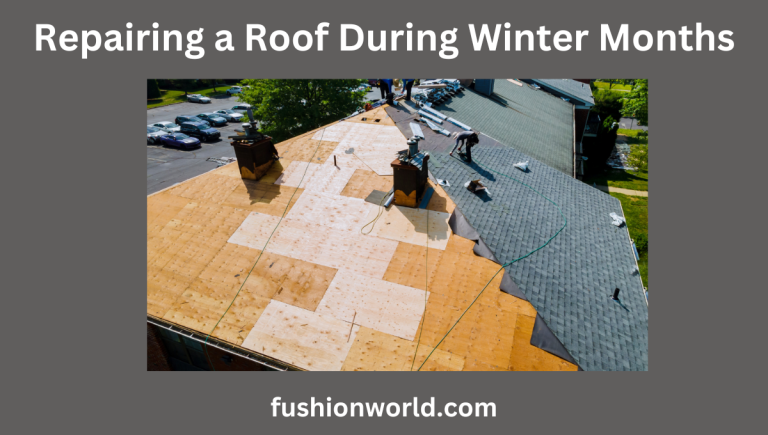Introduction
Welcome to our extensive guide on winter roof repairs. As the cold season approaches, it’s crucial to understand how to address roofing issues that can arise during the winter months. In this article, we’ll delve into the world of winter roof repair, answering common questions and concerns homeowners often have. Keep an eye out for keywords like ‘Can you patch a tar roof in the winter,’ ‘winter roof repair,’ and ‘patch shingles winter‘ as we explore this important topic.
Winter Roof Repair Fundamentals
We’ll lay the groundwork for understanding why winter roof repairs are essential. We’ll discuss the unique challenges of repairing roofs when it’s cold outside and how this differs from warmer weather repairs. We will navigate through this exploration with keywords such as ‘winter roof repairs’ and ‘repairing roofs in winter.
Winter brings a host of challenges to roofing. The cold temperatures, snow, ice, and freezing rain can take a toll on your roof’s integrity. To ensure your home stays warm, dry, and safe, it’s essential to address any issues promptly.
Assessing the Damage
It is all about assessing the damage. We’ll explain how to identify roofing issues during the winter, providing you with valuable tips for conducting a thorough roof inspection even in freezing temperatures. We’ll also explore ‘leaking roof repair in winter‘ and ‘how to repair a roof’ in the upcoming sections.
To begin your winter roof repair journey, you must first assess the damage. Climbing onto the roof during winter can be challenging, but it’s necessary to identify issues before they escalate into major problems.
Initiate the inspection process by conducting a visual examination of your roof’s exterior from a safe distance on the ground. Keep an eye out for clear indications of issues like shingles that are either missing or in a damaged state, areas with noticeable sagging, or the presence of ice dams forming along the eaves. For a more detailed examination, consider utilizing binoculars to gain a closer perspective.
Temporary Fixes for Leaks
Next, in section three, we’ll discuss temporary solutions for addressing roof leaks during the winter season. You’ll learn about the process of patching shingles and tar roofs in cold weather conditions, including phrases like ‘patch shingles winter heat gun‘ and ‘can you patch up a roof in winter?
When you discover a leak during the winter, it’s crucial to act quickly to prevent further damage to your home’s interior. Here are some quick adjustments you might want to think about:
Use Roofing Cement: Roofing cement is designed to adhere to wet surfaces, making it a suitable choice for patching leaks during the winter. Apply a generous amount over the damaged area, making sure to press it into any cracks or gaps.
Use a Tarp: If the leak is extensive and you can’t immediately repair it, consider using a tarp to cover the affected area. Secure the tarp tightly to prevent water from seeping through.
Heat Guns and Shingle Patches: For shingle repairs, a heat gun can be used to soften the shingle material, allowing you to press it back into place. Apply roofing cement or specialized shingle patches to seal the damaged area.
Remember that these fixes are temporary and should be followed up with permanent repairs during more favorable weather conditions.
Professional Roof Repairs in Winter
In section four, we’ll highlight the advantages of enlisting the help of professional roofers for winter repairs. We’ll share tips on finding and collaborating with experienced roofing contractors while addressing queries like ‘can you fix a roof in the winter‘ and ‘do roofers work in the winter.’
While DIY solutions can be effective for minor issues, professional roof repairs during the winter offer several benefits:
Expertise: Experienced roofing professionals understand the unique challenges of winter repairs and have the knowledge to address them effectively.
Safety: Roofing can be hazardous, especially during the winter when surfaces are slippery and conditions are unpredictable. Professionals are equipped with safety gear and training to minimize risks.
Quality Materials: Roofing contractors have access to high-quality materials and tools that may not be readily available to homeowners, ensuring a more durable and lasting repair.
Warranty: Many professional roofing repairs come with warranties, providing peace of mind that the work is guaranteed.
To find a reliable roofing contractor, start by asking for recommendations from friends, family, or neighbors who have had roofing work done recently. Additionally, look for contractors with positive online reviews and check their credentials, licenses, and insurance.
DIY Winter Roofing Tips
For those inclined to tackle their own winter roof repairs, section five provides a step-by-step guide. We’ll offer instructions for smaller repairs that homeowners can safely undertake, covering topics like ‘proper repair shingles cold‘ and ‘shingling in cold weather.‘
While we recommend professional assistance for significant repairs or roof replacement during winter, there are some DIY tips you can follow to address minor issues:
Safety First: Before attempting any repairs, ensure you have the appropriate safety gear, including non-slip shoes and a safety harness.
Clear Snow and Ice: Remove any snow or ice buildup on your roof carefully using a roof rake or a snow removal tool designed for roofs. By doing so, ice dams may be avoided.
Inspect Flashing: Examine the flashing around the skylights, vents, and chimneys. Apply roofing cement to seal any gaps or damage you find in the meantime.
Patch Small Holes: If you identify small holes or cracks in your roof, you can use roofing cement or roof sealant to patch them. Prior to placing the patch, make sure the region is dry and clean.
Inspect Gutters: Keep your gutters clear of debris to prevent ice dams and ensure proper drainage.
Remember that DIY repairs should be limited to minor issues, and it’s essential to prioritize safety at all times. If unsure, seek advice from a roofing expert.
Replacing a Roof in Winter
Examines the possibility of replacing an entire roof during the winter season. We’ll discuss the challenges and precautions associated with this significant undertaking such as ‘replacing a roof in the winter‘ and ‘can you replace a roof in winter.’
Replacing a roof in winter is not the ideal scenario due to the cold and potentially unpredictable weather. However, in some cases, it may be necessary, especially if your roof is severely damaged and poses a significant risk to your home’s interior.
Here are some considerations when contemplating a winter roof replacement:
Temperature: Extreme cold can affect the flexibility of roofing materials. Consult with a roofing professional who has experience working in cold weather to assess whether it’s feasible.
Weather Forecast: Plan the replacement during a period of relatively mild weather. Avoid scheduling the project during snowstorms or freezing rain.
Preparation: Ensure the roofing contractor takes necessary precautions to keep the roofing materials and adhesive warm, as cold materials can become brittle.
Safety Measures: The safety of the workers is paramount. Make sure the roofing crew has the appropriate gear and follows strict safety protocols.
Indoor Protection: During the replacement, take measures to protect the interior of your home from dust and debris.
Before deciding on a winter roof replacement, consult with multiple roofing contractors to gather opinions and estimates. If possible, explore temporary repair options until a full replacement can be scheduled in more favorable weather conditions.
Winter Roofing Safety
In our final section, we’ll emphasize the importance of safety when working on roofs during the winter. We’ll provide essential guidelines for staying safe in cold, icy, and potentially hazardous conditions, addressing ‘roof repair winter snow‘ and ‘roofing in the winter.’
Working on a roof in winter can be risky, but taking the right precautions can help minimize these risks:
Safety Gear: Ensure you and any professionals working on your roof are equipped with appropriate safety gear, including non-slip footwear, safety harnesses, and helmets.
Weather Monitoring: Keep an eye on the weather forecast and avoid working on the roof during extreme conditions, such as heavy snowfall or icy rain.
Clear Pathways: Remove snow and ice from ladders and roof access points to prevent slipping hazards.
Caution with Tools: Cold temperatures can affect the performance of tools. Be cautious when handling them and ensure they are in good working order.
Teamwork: Don’t work alone on the roof during winter. Put a person on the ground so they can help if necessary.
Emergency Plan: Have an emergency plan in place, including contact information for medical assistance if an accident occurs.
Conclusion
In conclusion, this comprehensive guide has covered a wide range of topics related to winter roof repairs. We’ve highlighted the significance of addressing winter roofing issues promptly and responsibly. Whether you’re looking for DIY tips or considering professional help, this guide aims to equip you with the knowledge you need to protect your home during the cold months ahead.
By following these guidelines, you can ensure that your roof remains in good condition throughout the winter, keeping your home warm, dry, and safe. Remember that safety should always be a priority, and when in doubt, consult with roofing professionals to address more significant issues. Stay warm and secure this winter!

